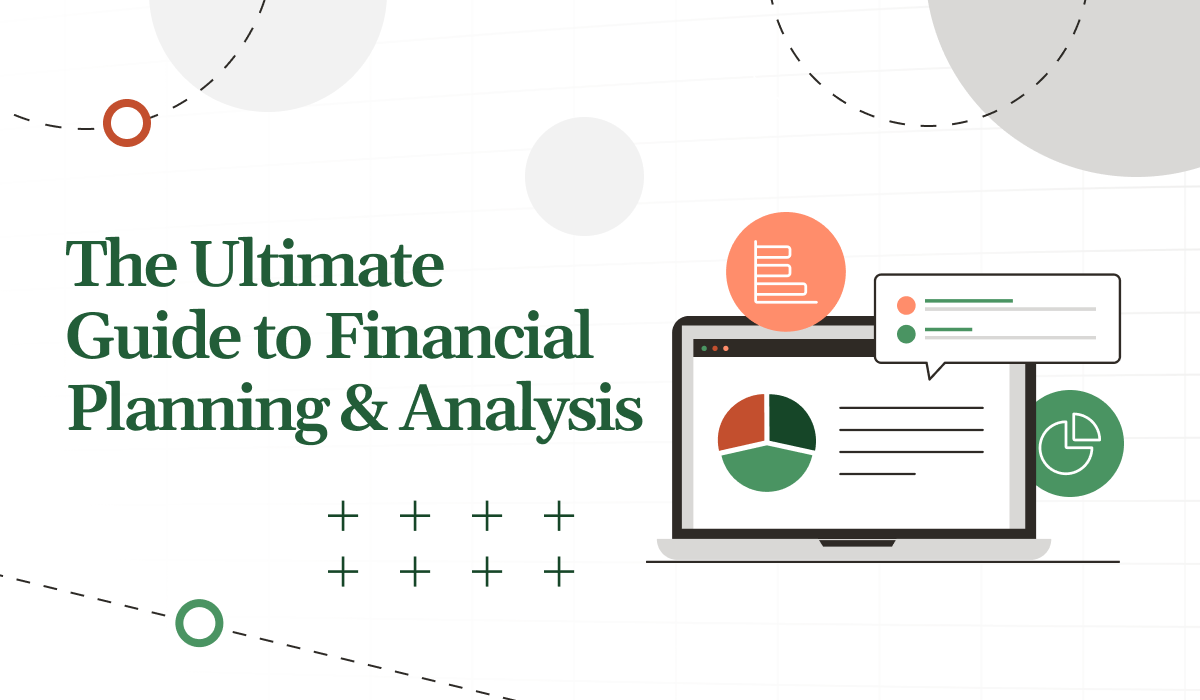
This blog was first published in 2019 and updated on December 8, 2021.
The importance of financial planning and analysis cannot be understated. Without the right planning, analysis and finance leadership, no company can reach its full potential.
Financial planning and analysis (FP&A) is incredibly important. Without careful planning, analysis, and the right finance leadership, a company can't realize its full growth potential. It's that simple.
Despite its crucial role in operations, FP&A has often been siloed, having little communication with other departments.
This post covers a 2020 study that found data silos were a challenge for 57% of finance teams.
In the past, data collection and reporting were time-consuming manual processes, and strategic insights were limited in scope and executive influence (e.g. standard financial statements). But thanks to advancements in cloud technology, automation, and modern analytics, FP&A has now emerged as an essential bridge between finance and operations.
Modern FP&A helps to drive informed financial and business decisions. Today, FP&A professionals have a front seat in revamping lines of business, driving budgets, and forecasting clear paths to achieve operational goals. Well-run FP&A team functions by connecting the dots of multiple departments to help guide the strategic decisions of its business leaders.
Modern financial planning and analysis is a wide-ranging set of processes, data, tools and people. As such, this guide will focus on the basics: what FP&A is, why it's important, and what FP&A teams do. Additionally, and importantly, we will also discuss how FP&A software works.
FP&A takes advantage of powerful analytics and financial modeling to inform the business planning process. Done right, it considers historical and forecasted financials and operational data, changing market conditions and company-wide performance to help determine the best opportunities for future growth and profitability.
FP&A is best described as a continuous cycle of data collection and analysis, management reporting, forecasting and planning and--finally--execution and financial close management.
Each step informs the next:
As those plans unfold and the books are closed at the end of a fiscal period, the cycle begins again.
The FP&A function can analyze an organization as a whole, examine individual departments and capture day-to-day operational data in real-time. FP&A uncovers financial and operational insights to create more accurate forecasts and to aid executives in making well-informed business decisions to meet short- and long-term goals.
FP&A is breaking out of its traditional finance silo and taking on a more visible role across organizations. Now, it's time for FP&A teams to take advantage of this opportunity and establish themselves as vital partners to support the entire business.
By owning and analyzing data and being able to translate company-wide insights into actionable plans, FP&A helps businesses meet objectives including:
Properly implemented FP&A can mean the difference between profit and loss. That's why corporations are increasingly reliant on FP&A to provide the roadmap for achieving broad operational goals. These financial roadmaps need to be well communicated, agile and monitored continuously to keep up with ever-changing market conditions and competitive challenges and take advantage of new opportunities as they arise.
FP&A teams play an integral part in informing corporate strategy, providing insights into planning, budgeting and forecasting, and tying them to achieving overall company goals.
Today, financial planning and analysis professionals work side by side with business decision-makers. They weigh in on business planning and analyze the full implications of changing corporate plans, market conditions, and other drivers.
You can frame the role by thinking about it in relation to another important finance team member: the accountant. An accountant typically processes and reports on actual financial transactions. On the other hand, FP&A professionals compare these numbers against budgets and forecasts to identify telling variances, using that information to guide business leaders on what to do moving forward.
In other words, FP&A teams are financial storytellers with direct influence on corporate strategy.
The FP&A professional fits into an organization by helping connect the dots across departments. Lining up goals between financial and operational leadership can help identify ways to improve the bottom line. As a result, the FP&A role no longer resides exclusively in the finance department. But instead, it falls somewhere between the CFO and COO, helping to drive more strategic decisions.
In the past, FP&A relied on building financial and analyzing monthly or quarterly financial results, primarily in Excel. But as the role of FP&A continues to evolve, technological proficiency, communication skills and the ability to tell a story through data, analytics and BI will equip FP&A professionals to address the modern demands they face.
The key skills and capabilities today's FP&A teams need--beyond the annual budget or month-end close--to do modern FP&A effectively are broader and more business-focused than they were only a decade ago. For each skill set of today's FP&A teams, the corresponding FP&A applications are as follows:
The career path for an FP&A professional continues to evolve. Advances in process automation have cut down on the hours typically spent collecting, consolidating and verifying numbers. As a result, this frees up valuable time to analyze data, investigate discrepancies, and transform insight into confident action.
Modern FP&A software provides real-time reporting and personalized, self-service dashboards with accurate numbers and intuitive drill-down capabilities. Templates, forecasts, budgets and reports can be easily shared throughout an organization without worrying about data integrity. A central, connected database and built-in version control ensure that everyone is looking at the right data.
Cloud technology enables modern FP&A software to connect a company's existing templates and models to a central database. At the same time, process automation liberates FP&A teams from tedious, manual processes like collecting and verifying company-wide data.
For years, FP&A teams relied on Excel to report, forecast and budget. It makes sense: Excel is intuitive, flexible and found everywhere in business. However, for all of its advantages, Excel has some serious limitations in scalability, collaboration, and control, among others. It can be challenging to share Excel worksheets efficiently while maintaining control of document versions and process workflow. Excel's renowned flexibility can also be its greatest weakness, with minor changes potentially throwing off entire budgets, forecasts, models and reports.
Case in point: at companies with typical financial planning and analysis or corporate performance management (CPM) software, 84% of the time, end-users end up hitting "Export to Excel." Why? Because they're so familiar with the ins and outs of their favorite spreadsheet software.
While this approach might work great for short-term tasks, it creates a "shadow system" of disconnected spreadsheets with challenges around version control, audit trails, data integrity and other issues--ultimately the same challenges that the FP&A software was implemented to solve in the first place.
An offline, disconnected Excel spreadsheet system can show budget owners and management obsolete, inaccurate and competing versions of what should be consistent numbers. Other challenges with Excel include:
Companies often export-controlled data from FP&A and other source systems, manually copying and pasting that data into Excel to take advantage of its familiar, intuitive interface. Even if the data was copied and pasted perfectly (which is rarer than it might seem), it's still a highly inefficient transfer method.
Excel lacks a robust built-in mechanism to track changes by cell or user, and it doesn't offer the ability to revert to a previous version if errors are encountered. The result: questionable data accuracy and integrity.
Excel cannot track tasks across projects, users and organizations, or the ability to set user-level permissions and access levels. This means it's nearly impossible to keep track of who's doing what at any given time.
Excel is a powerful, intuitive and feature-rich program, but one thing it's not is a database. Trying to combine, analyze or report on large volumes of data in a standalone spreadsheet simply isn't practical.
Some modern FP&A software vendors try to solve the limitations of Excel through imitation. But unfortunately, it's quite the opposite. Many go to great lengths to try and recreate the familiar feel, flexibility and performance of Excel, but they never duplicate the full Excel experience. They almost always require extensive training and a steep learning curve--especially for business users.
Features like data integration and version control eliminate many of Excel's limitations, but the vast majority of users still have a hard time moving past Excel. Most finance professionals have used it their entire careers and will often go out of their way to use what they're most comfortable with: real, full-featured, flexible Excel.
The ideal solution is to combine the best of both worlds by using Excel as a window into a centralized, connected database. This approach enables teams to continue using Excel while adding:
Using Excel as an end-user interface allows you to connect your existing spreadsheets, templates and models to a central database governed by a sophisticated workflow engine and business rules. As a result, you continue to benefit from Excel's flexibility and unmatched computing power while doubling down on data integrity, usability, and security.
With a modern FP&A cloud solution that includes an Excel user interface and data integration capabilities, teams can drastically cut down on time it takes to close the books, create forecasts and populate reports. Powerful analytics can lead to faster decision-making, accurate predictions, and better financial modeling.
As such, with modern FP&A software, an impressive number of processes can be automated, including:
With platform solutions that can accurately consolidate data and cut down on time it takes to compile reports, the role of the FP&A professional is shifting as a result. With that shift, communication, storytelling, and high-level data analysis skills will continue to be in high demand.
As FP&A evolves, it will continue to take on a larger role within organizations--FP&A will continue to live in finance. But the insight it provides and the stories it tells will inform decisions at the highest levels of the business.
Advancements in the software will continue to shape FP&A now and in the future. As artificial intelligence and predictive analytics begin to drive innovation in earnest, the ability for FP&A to lead organizational change will only continue to grow. As processes and tools evolve, FP&A will play an even more active role across departments as a result.
Cliche as it might seem, the future of financial planning and analysis is now.
Modern solutions seamlessly integrate with Excel, Power BI, Microsoft Office (and Office 365) and Google Suite, with automation to streamline critical FP&A processes so financial professionals can create and share accurate reports across teams with ease.
Modern FP&A solutions provide a single source of truth: a centralized database that provides trusted and timely budgets, forecasts and reports to educate and inform decision making with insightful analysis across an organization.
Did you learn a lot about financial planning and analysis in this post? Here are three more posts to read next:
Evan Webster is an experienced sales professional and storyteller with a passion for innovative technology. He currently serves as a Senior Area Sales Manager at Vena and previously worked as a Content Specialist. He continually strives to inspire finance professionals to become strategic business partners and is dedicated to helping them automate and streamline their planning processes so they can make better decisions with reliable, data-driven insights—enabling meaningful growth for organizations across the globe.
